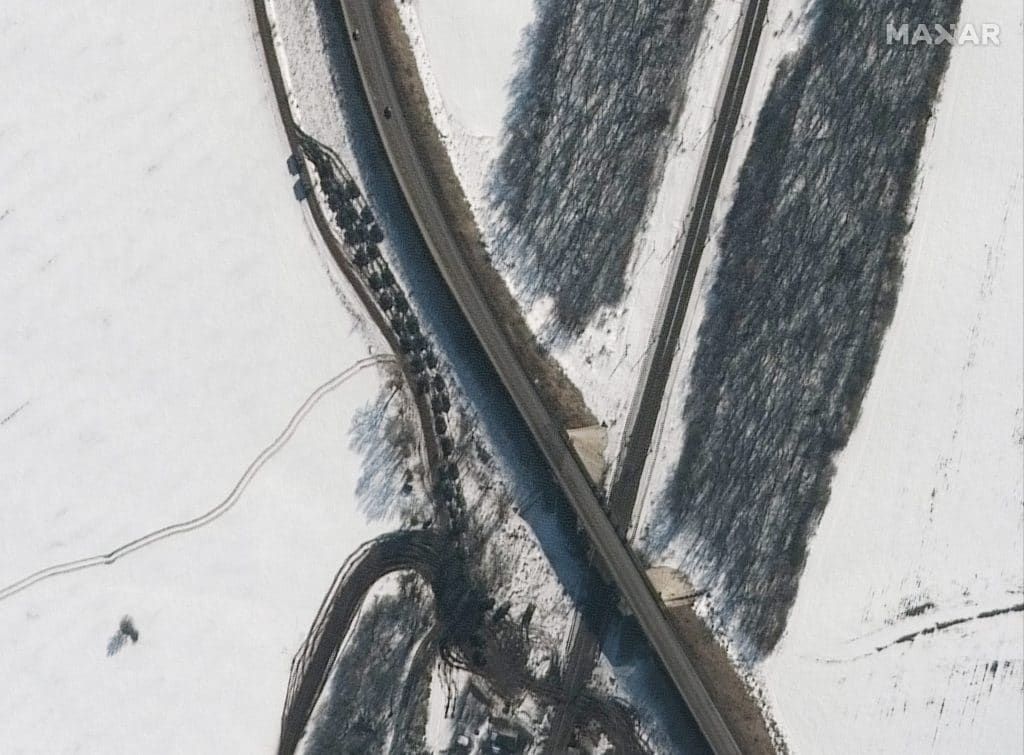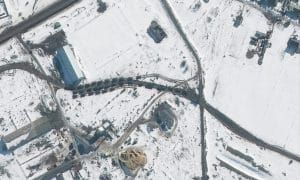In fiery speech, Putin recognizes Ukraine separatist regions; Russian troops ordered to Eastern Ukraine
By John Mecklin | February 20, 2022
 An armored battalion heading south from soloti, Russia
An armored battalion heading south from soloti, Russia
Editor’s note: This is a developing story; it has been updated since its initial publication and will continue to be updated as necessary. For full Bulletin coverage of the Ukraine crisis, click here.
In an aggrieved speech Monday, Russian President Vladimir Putin recognized two separatist regions of Eastern Ukraine as independent and signed orders authorizing Russian troops to enter the putative Donetsk and Luhansk People’s Republics for “peacekeeping functions.” The Biden administration responded by ordering limited economic sanctions related to those regions, apparently holding more sweeping sanctions in reserve should Russia undertake a wholesale invasion of Ukraine. The European Union and a variety of European countries decried Putin’s announcement and threatened their own sanctions. It was not immediately clear whether Russian troops would attempt to expand the areas occupied by Ukrainian separatists to include the rest of Donetsk and Luhansk, which are now occupied by the Ukrainian army. Putin’s speech—described as emotional, aggrieved and fiery in the New York Times—argued that Ukraine was historically created by and linked to Russia and assailed NATO for its eastward expansion. Many Ukrainians support an independent Ukraine that leans toward Europe rather than Russia. Ukraine is not a NATO member, although it has indicated interest in joining the alliance.
Putin’s announcement on Monday came as Russia appeared to continue preparations to invade Ukraine. On Sunday, it blamed renewed conflict in the eastern portion of that country on “provocations of the Ukrainian security forces” and moving tens of thousands of Russian troops into what appeared to be combat formations. Meanwhile, US President Joe Biden met with the National Security Council, just days after announcing that US intelligence had convinced him Russian President Vladimir Putin had ordered an invasion of Ukraine.
In a CNN appearance early Sunday, US Secretary of State Antony Blinken said, “As we’ve described it, everything leading up to the actual invasion appears to be taking place. All of these false flag operations, all of these provocations to create justifications—all of that is already in train.
“But you heard President Biden say this the other night: We believe President Putin has made the decision, but until the tanks are actually rolling and the planes are flying, we will use every opportunity and every minute we have to see if diplomacy can still dissuade President Putin from carrying this forward.”
Also on Sunday, Putin and French President Emmanuel Macron talked via phone. The French readout of the call suggested that the two leaders had discussed diplomatic and other moves to de-escalate the Ukraine situation. But in its response to the call, the Kremlin emphasized allegations of provocation and belligerence by Ukraine and NATO. Moscow provided no evidence to support the claims, which appear to be untrue. Ukrainian President Volodymyr Zelenskiy has reportedly ordered Ukrainian security forces to exercise maximum restraint. And in comments after an appearance at the Munich Security Conference on Saturday, Ukrainian Zelenskiy said, “We are ready to sit down and speak. What’s the point of us shooting and proposing diplomacy at the same time?”
Late on Sunday, the White House said Biden had agreed “in principle” to meet with Putin in a summit broached during Macron’s call with the Russian leader. Such a meeting would occur only after the US and Russian foreign ministers meet later this week, and only if Russia does not invade Ukraine, White House officials said. The New York Times reported that one US official “called it all completely notional, and said that all evidence suggests Russia still intends to invade Ukraine in the coming days.” The possibilities for a summit seemed even bleaker after Putin ordered Russian troops to enter Eastern Ukraine on Monday.
Beyond the statements by US officials, evidence that Russian forces were preparing for an assault on Ukraine continued to pile up on over the weekend. The evidence included satellite photographs showing Russian military units deploying outside bases in what appeared to be attack formations.
Satellite imagery from Maxar Technologies revealed new activity associated with the Russia-Ukraine situation. Imagery from Sunday showed new field deployments of armored equipment and troops northwest of Belgorod and near Soloti and Valuyki, Russia. “This new activity” the company reported, “represents a change in the pattern of the previously observed deployments of battle groups (tanks, armored personnel carriers, artillery and support equipment). Until recently, most of the deployments had been seen primarily positioned at or near existing military garrisons and training areas. … Today, most of the combat units and support equipment at Soloti have departed and extensive vehicle tracks and some convoys of armored equipment are seen throughout the area. Some equipment has also been deployed east of nearby Valuyki, Russia in a field approximately 15 kilometers north of the Ukraine border. Moreover, a number of new field deployments are also seen northwest of Belgorod (deployments are approximately 30 kilometers from the border with Ukraine) with much of the equipment and troops positioned in or near forested areas. Other company-sized units are deployed within farm and/or industrial areas.”

Sentinel-2 imagery of the new helicopter base at Tomarovka airfield, geolocated by @bobmoretti.
Comparison between Feb 05 and 15. https://t.co/Ap0AepRFXt pic.twitter.com/4SYRuvWiy3— Michael Sheldon (@Michael1Sheldon) February 17, 2022
Same location as this: https://t.co/35XzxID9BB@DefMon3 I found the location!
50.7009, 36.2902— bobmoretti (@bobmoretti) February 17, 2022
The New York Times reported that one TikTok video showed Russian military movements less than five miles from the Ukrainian border. In another ominous development, joint military exercises between Russian and Belarus that had been scheduled to end this weekend were extended, the Belarusian defense minister announced on Sunday, because of increased tensions in Eastern Ukraine.
The continuing movements toward an invasion followed Russian strategic exercises last week in which missiles capable of carrying nuclear weapons were test-fired. The strategic exercises were the second rattling of the nuclear saber during the Ukraine crisis. Early in February, in answer to a question from the media, Russian President Vladimir Putin said allowing Ukraine to join NATO would increase the prospects of a Russia-NATO conflict that could turn nuclear. Putin’s assertion, made in the context of a complicated hypothetical about an unlikely Ukrainian attempt to take Crimea back from Russia, came during a joint press conference with Macron.
Together, we make the world safer.
The Bulletin elevates expert voices above the noise. But as an independent nonprofit organization, our operations depend on the support of readers like you. Help us continue to deliver quality journalism that holds leaders accountable. Your support of our work at any level is important. In return, we promise our coverage will be understandable, influential, vigilant, solution-oriented, and fair-minded. Together we can make a difference.
Keywords: Antony Blinken, Emmanuel Macron, Joe Biden, Russia, Ukraine, Vladimir Putin, invasion
Topics: Nuclear Risk














